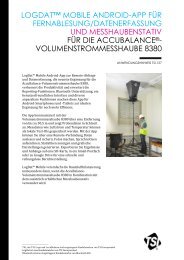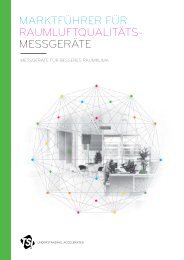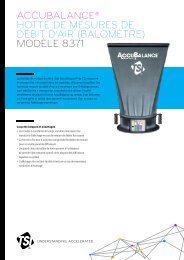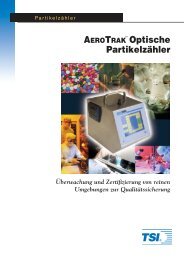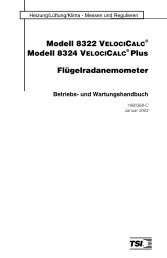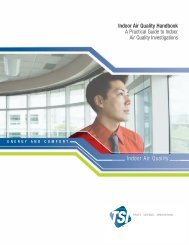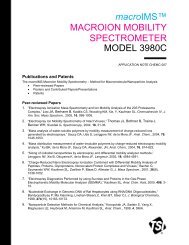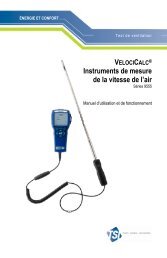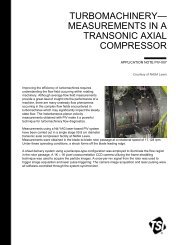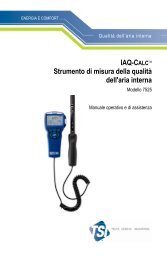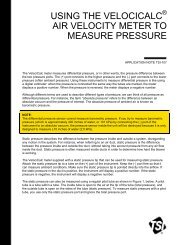Model 3340 Laser Aerosol Spectrometer Bibliography - Tsi
Model 3340 Laser Aerosol Spectrometer Bibliography - Tsi
Model 3340 Laser Aerosol Spectrometer Bibliography - Tsi
Create successful ePaper yourself
Turn your PDF publications into a flip-book with our unique Google optimized e-Paper software.
Thompson, M.W.; Donnelly, J.; Grinshpun, S.A.; Juozaitis, A.; Willeke, K. “Method and Test System for<br />
Evaluation of Bioaerosol Samplers,” Journal of <strong>Aerosol</strong> Science, 25:8, (1994) 1579–1593.<br />
Abstract: A method and test system have been developed for the laboratory evaluation of the<br />
performance of bioaerosol samplers. The method differentiates between the overall physical sampling<br />
efficiency (which reflects the inlet and collection efficiencies) and the biological sampling efficiency<br />
(which reflects the survival of the test microorganisms during the sampling process). The number<br />
concentrations of laboratory-generated bioaerosol particles are measured with an aerosol size<br />
spectrometer up- and downstream of the bioaerosol sampler being tested. In a bioaerosol impactor,<br />
which was specially designed for testing microbiological aspects of bioaerosol sampling, the inlet and<br />
collection efficiencies are differentiated by measuring downstream of the collection surface location<br />
with and without the collection surface in place. The number of recovered particles is counted as<br />
microcolonies with a microscope after sampling the bioaerosol particles into agar and culturing them.<br />
The total recovery of these bioaerosol particles is determined as a ratio of the number of viable<br />
microorganisms recovered to the number of bioaerosol particles present in the air sampling volume<br />
upstream from the sampler. This total recovery is a measure of the ratio of culturable to nonculturable<br />
bacteria present in the air. By measuring physical and microbiological aspects<br />
simultaneously, information is gained on aspects of bioaerosol sampling that cannot be determined by<br />
either of these branches of science alone. This is exemplified by tests on the influence of relative<br />
humidity and desiccation time on colony count.<br />
The newly-developed system can be used to test any bioaerosol sampler. A special single-stage<br />
impactor was designed, built and used to study how different sampling and analysis variables affect<br />
the total recovery of bioaerosol particles. The designed impactor was calibrated using PSL particles.<br />
Its inlet sampling efficiency was found to be within the range of 96 to 99.5%, depending on the<br />
sampling conditions and particle size, if the latter is less than 8 µm (this range represents single<br />
bacteria, bacterial agglomerates, and fungi). The collection efficiency was found to be about 100%<br />
when collecting PSL particles larger than 0.7 μm in diameter at 201 min −1 or higher air flows.<br />
The total recovery of microorganisms measured under these conditions is characterized only by the<br />
“survivability” of microorganisms during their sampling. It was found that relative humidity had a<br />
pronounced effect on total Pseudomonas fluorescens recovery. Experimental data also showed that<br />
the sampling time may be limited due to bacterial desiccation and subsequent loss in viability of<br />
collected microorganisms.<br />
1993<br />
Peters, K.; Gerchau, J.; Bruckner, G. “The Filtering of <strong>Aerosol</strong> Particles by a Spruce Canopy-<br />
Measurements Versus <strong>Model</strong> Calculations,” Journal of <strong>Aerosol</strong> Science, 24, (1993) S313–S314.<br />
1992<br />
Schiller-Scotland, C.F.; Hlawa, R.; Gebhart, J.; Wonne, R.; Heyder, J. “Total Deposition of <strong>Aerosol</strong><br />
Particles in the Respiratory Tract of Children during Spontaneous and Controlled Breathing,” Journal of<br />
<strong>Aerosol</strong> Science, 23:S1, (1992) 457–460.<br />
Abstract: Medical doctors found out that in comparison to adults the number of children with<br />
airways decrease due to air pollution is much higher. However up to now experimentally data for total<br />
deposition of aerosol particles in the human respiratory tract are predominantly published for adults.<br />
In the present study 29 children with normal lung function data volunteered for the determination of<br />
total deposition using an inline inhalation technique. It turns out that total deposition data for children<br />
are higher than for adults, and thus confirm a general tendency already reported by BECQUEMIN et<br />
al. (1986). Using the inline technique the differences in deposition values between children and adults<br />
are more pronounced than found by those authors.<br />
-32-



